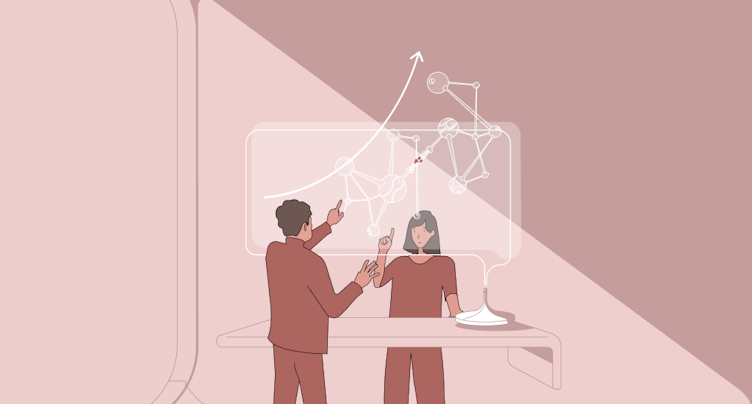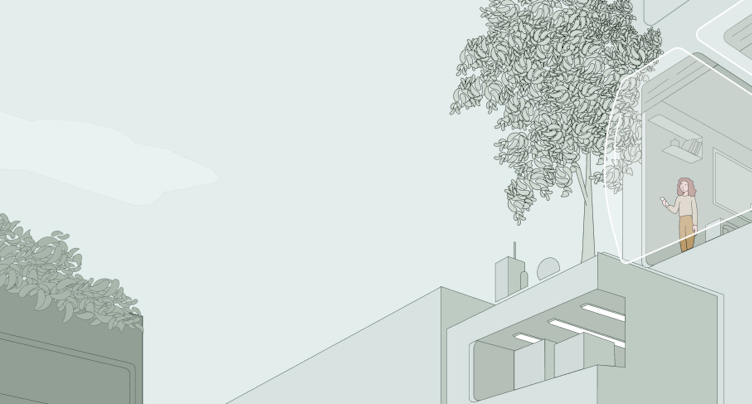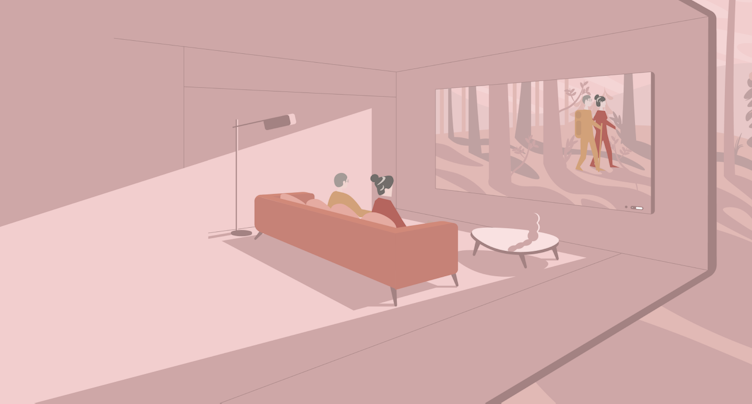share this post on

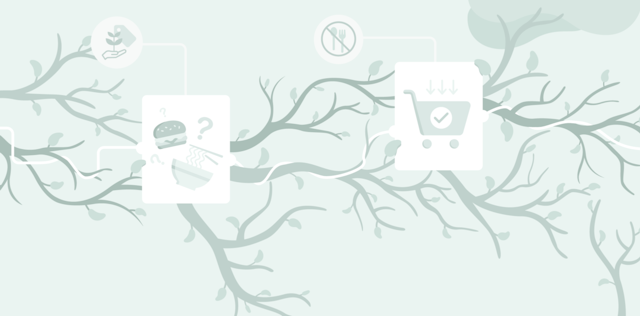
21 January, 2021
Since our world is growing increasingly conscious about the environment, leading brands, products and services are also becoming ever more eco-friendly. This trend has brought along a crucial need for businesses to adapt and service the constantly growing demand for green solutions. After all, nobody wants to miss out on grabbing the brass ring of the decade!
Making use of the tools of nudging, gamification and eco-friendly features, digital product designers can truly pull their weight and help pave the way towards a more liveable and sustainable Earth.
Eco-friendly design solutions + demand for sustainability = a greener Earth?
Over the last decade humanity has been facing a serious challenge it has never before encountered: climate change. We live in a world where sustainability is becoming a priority in all areas of life, and that includes design too. But what can we actually accomplish through digital product design to move matters forward?
It’s rather simple, really: in consumerist societies it’s ultimately up to the joint effort of designers and businesses to include environmentally friendly options in products that will help conserve resources and minimise pollution.
Let’s talk about your future
In other words, we need to design products in a way that will enable customers to have a positive (or at least, zero) impact on their environment.
Think of a food ordering app, where you have two options at the checkout: A, choose a recycled bag or B, get a normal one. Which one would you go for? Let’s hope that 50% of users will choose recycled packaging, and voilà: the need for producing plastic bags for that particular company has been decreased by 50%. To make this happen in the first place we need the option to choose. (Okay, we also need recycled bags, but let’s assume the company already has them). In order to include this option in this imaginary app, designers have to design it and the company has to enable it. However, the impact of design(ers) is only the first half of our equation.
Let’s examine the second half. We now have sustainable designs, but what will people actually do with them? Will they opt for the “green” choice? According to the 2017 Eurobarometer results 94% of EU citizens consider the protection of the environment an important issue. In the US a recent research has found that when it came to consumer packaged goods (CPG), 50% of the growth experienced between 2013 and 2018 came from sustainability-marketed products.
All in all, several sources point to the fact that environmental responsibility is shaping people’s shopping habits and decisions.
And now – as always – businesses are following the market demand. For example, ASOS (a major fashion e-commerce brand) has launched a “responsible” filter on their website that helps users refine their search results for sustainable clothes.
Other companies are building their entire business model around sustainability. The American company Patagonia is selling outdoor clothing and gear in an environmentally and socially responsible way; a philosophy that is in fact a core part of their branding. They created a constantly growing niche market, and their sales surpassed $1 billion in 2018. Patagonia truly puts the cherry on top by giving tips on how to make your clothing last longer and offering free repairs – a move that seemingly no sane, profit-oriented business would do, right? Patagonia also introduced a second-hand online marketplace named “WornWear”, whose sales have surpassed $1 million in the first six months of its operation. Part of the success story is how their unique business model supports employer branding: for their 2018 summer internship they received more than 9,000 applications… for only 16 open positions.
So, we seem to have arrived at a rather solid (albeit somewhat simplified) action plan:
- designers design eco-friendly solutions;
- businesses enable them;
- people are willing to opt for the greener choice;
- as a result, we are living in a more eco-friendly way on our planet!
This looks like a very neat equation – but how to get there?
How do digital product designers create sustainable solutions? And how to increase the demand for these?
Product designers and their magical wand
What if we say that designers, like invisible magicians, have the tools to redirect users towards better choices? This ultimately means that we can influence all parts of our hypothetical equation at the same time. Because designers in fact do have this tool, and it’s called the “Nudge”. (The Nobel-prize-winning “Nudge theory” by Richard Thaler and Cass Sunstein has gained popularity even in the fields of politics and economics.)
Nudging comes into play when people have to make a choice. In fact, we are being nudged all the time (both online and offline) and in most cases we don’t even realise it. Think about your last shopping trip: top-performing items somehow always seem to be positioned at eye-level to nudge customers into making unplanned, spur-of-the-moment purchases. We are being nudged when selecting a subscription plan: there’s always an “economical” or “most popular” choice in the middle – and people tend to choose just that.
Nudging is based on the simple fact that humans make most of their decisions unconsciously, and their judgment is always influenced by invisible biases. The way choices are presented is a Nudge in itself, since arranging them in a specific order will make people more likely to choose the one strategically positioned option over the others.
With all that said, it’s important to underline that nudging is not to be confused with restricting one’s options. When offering subscription plans we can, for example, change the visual appearance of each choice, even reshuffle their order, but we can’t actually prevent users from choosing whichever option they want.
The Nudge might be our primary design tool in digital products for directing people towards eco-friendly and efficient choices, but we have to apply it with care at all times.
Nudges are best complemented by eco-friendly functions. Let’s see a few ideas for green features you might be able to incorporate in your product:
- For e-commerce products with shipping selection: offer greener delivery options;
- For product sites involving comparison shopping: encourage users to compare options based on efficiency and eco-friendly ratings;
- For travel sites: display CO2 impact for each choice;
- Reduce paper usage by including functions that substitute processes with high paper needs, i.e.: offer e-receipts instead of offline ones, design online forms and document handling instead of offline solutions, issue e-tickets and passes instead of paper-based ones, etc.
The digital product designers’ cookbook contains another technique that can actively support the creation of eco-friendly products: namely, gamification. The concept has been defined, dissected and reinvented in numerous great articles and papers, but here’s the gist of it: gamification is adding elements of game to non-game activities in order to motivate people to do things.
Let’s examine some of these elements through the example of the Forest app, which helps users stay focused without checking/using their phone for a designated period of time. To create a purpose for not fiddling with their phone and to motivate them to go through with their plan, a digital seed is planted in a forest. As time passes (and the phone remains untouched), a tree starts growing on the screen, which evokes a satisfying sense of progression. By the time the designated phone-free period has been completed, the tree has grown fully and the user earns a certain amount of coins.
Gamification often applies coins or points as basic elements to reward users.
Forest also managed to smuggle a dollop of eco-friendliness into their app: as a reward for reaching a given number points, you can plant a real tree. On that note, it could have taken gamification a step further by adding badges after each tree planted, which would have increased the feeling of accomplishment and reward. Introducing a social aspect through a leaderboard and a function for inviting friends could also be useful for reinforcing users’ social status.
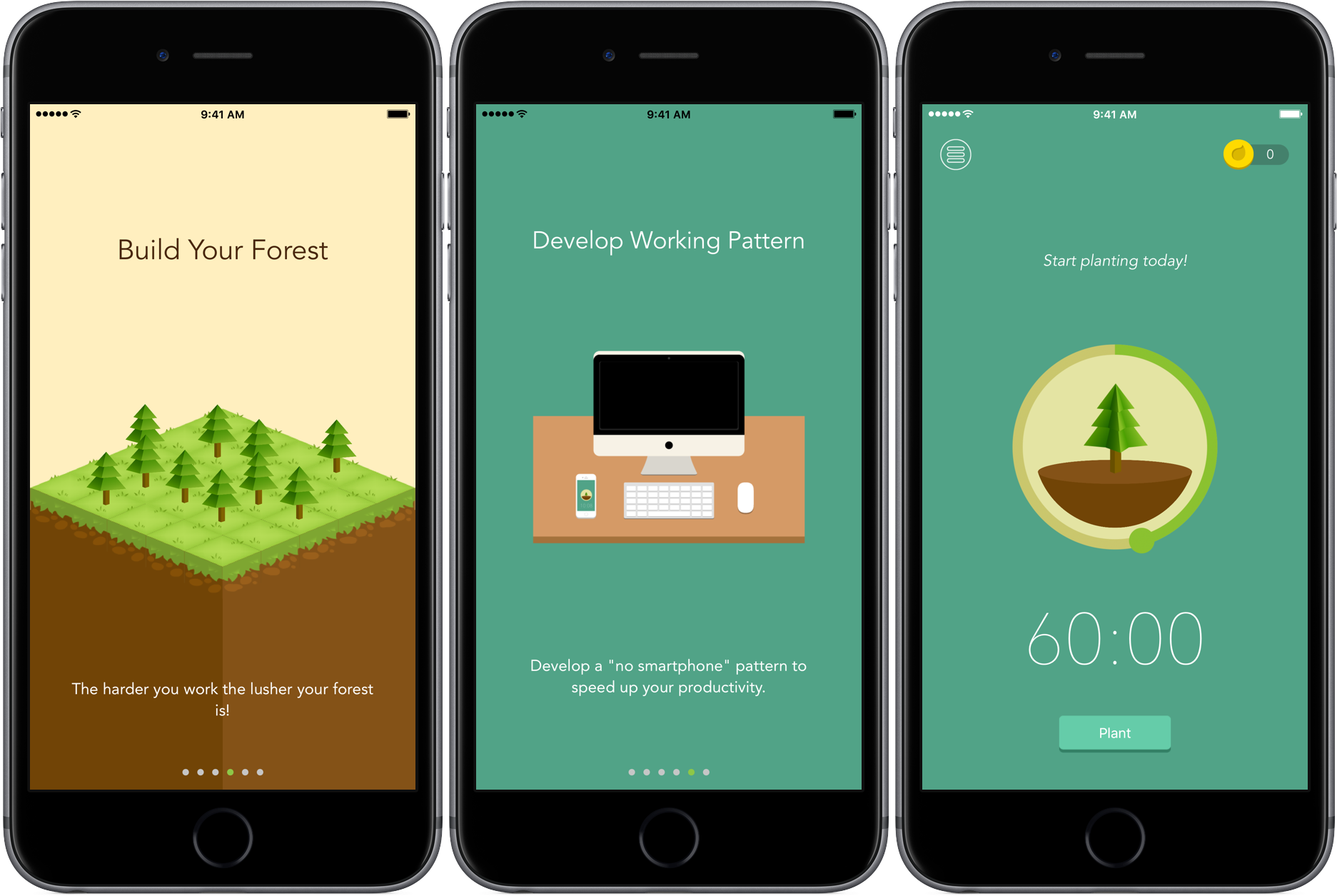
Gamification elements in the Forest app Source: Forest app (forestapp.cc)
Best practices to learn from
The good news is that a multitude of digital applications has managed to seamlessly implement eco-friendly functions and Nudges with great success – some of which are truly worth a look for inspiration.
The Swedish Doconomy mobile banking service tracks the CO2 footprint of your usage and helps you decrease it by carbon offsetting. The fintech app calculates the CO2 impact of each transaction and offers a chance to compensate it by funding UN-certified projects.
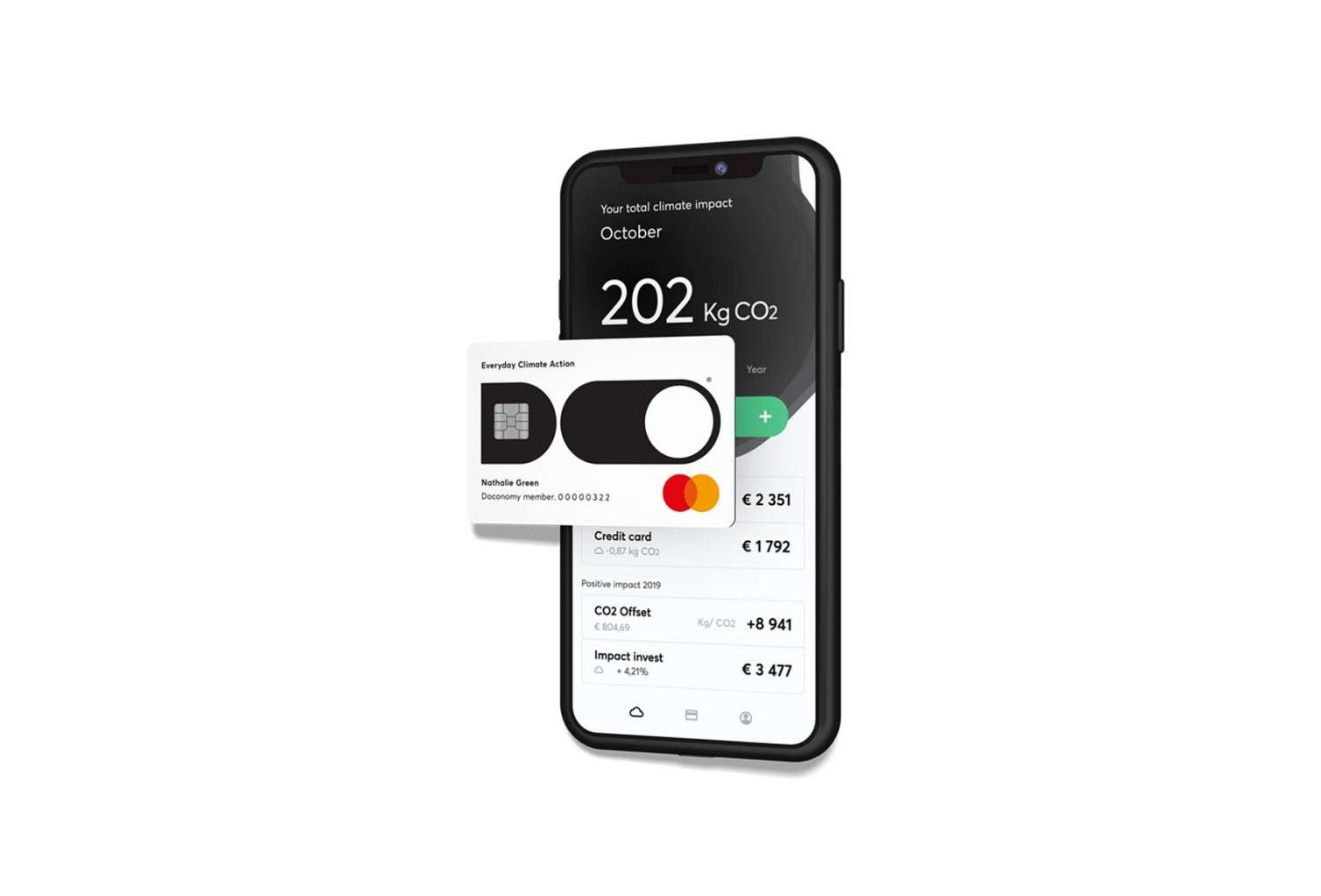
CO2 impact of transactions in Doconomy Source: Doconomy app
Opening the app, you’ll get a brief glance of your total greenhouse gas (GHG) emissions of the month. If your bank is connected to the app, a list of your latest transactions and their carbon impact appears (calculated by Åland Index). As far as eco-friendliness goes, it doesn’t get much more comprehensive than this!
The app offers a way to set up your personal emission goal, helping you to stay on track. With powerful gamification elements such as goal-setting and tracking, Doconomy motivates people to think greener, while also nudging users to compensate for their CO2 imprint through its “DO Credits” cashback system.
As we have seen, Doconomy is an application with a very specific eco-friendly approach, fulfilling a function that is tied closely to the issue of the environment. However, what can we say about more traditional companies whose current business models were not designed to include eco-friendly elements in the first place?
Hungary’s biggest commercial bank recently made the decision to digitise their processes.
Our team participated in their ambitious project to eliminate all paper-based bonds, leaving only digital bonds available to clients. The digitisation process has successfully decreased paper usage in every branch across the country and the solution has allowed thousands of bank administrators to go digital.
In the past applying for a real estate loan required clients to fill out several paper-based forms with information on their incomes, existing loans, personal data, etc. Now that the entire process is digital, consultants can record all important client data directly on their computers during a few customer appointments.
For credit pre-assessment, each paper-based form needed to be physically mailed to the bank centre every week, which generated significant CO2 emission. Thanks to the new online platform, the pre-assessment phase has also been digitised: after filling out all required details, the centre receives the pre-assessment online and is able to give feedback through the same platform.
Naturally, such far-reaching transitions are relatively costly ventures, and businesses can’t be expected to make them solely out of the goodness of their hearts. Luckily for us – and for the environment! – certain greener solutions often come with serious economic advantages in their own right. The bank’s most important motive for going digital was cost optimisation, yet significantly cutting down on their paper usage brought along the additional bonus of creating a positive impact on the environment.
Bringing it all together
We found that the easiest way to demonstrate the ideas outlined in this article would be through an imaginary app we designed for this very purpose. This is how our fictional food ordering app called “Good Food for You” came to be: it aims to showcase various eco-friendly functions that can effectively nudge users to opt for greener solutions.
The basic concept of Good Food for You is to decrease the carbon footprint of ordering food (and to deliver delicious meals, but that’s kind of beside the point now). Most of its functions don’t necessarily differ from a general food ordering app – but the Devil’s in the details, as all designers should know.
First, the user gives their location to access restaurants that deliver to their address. In addition to usual customer ratings, every restaurant has an eco-friendly rating based on their carbon footprint. Points are calculated using various factors, such as: whether they offer eco-friendly packaging, their delivery options, the quality of ingredients they use (locally sourced, palm oil-free, etc.), their energy or utility saving approach, or whether they recycle.
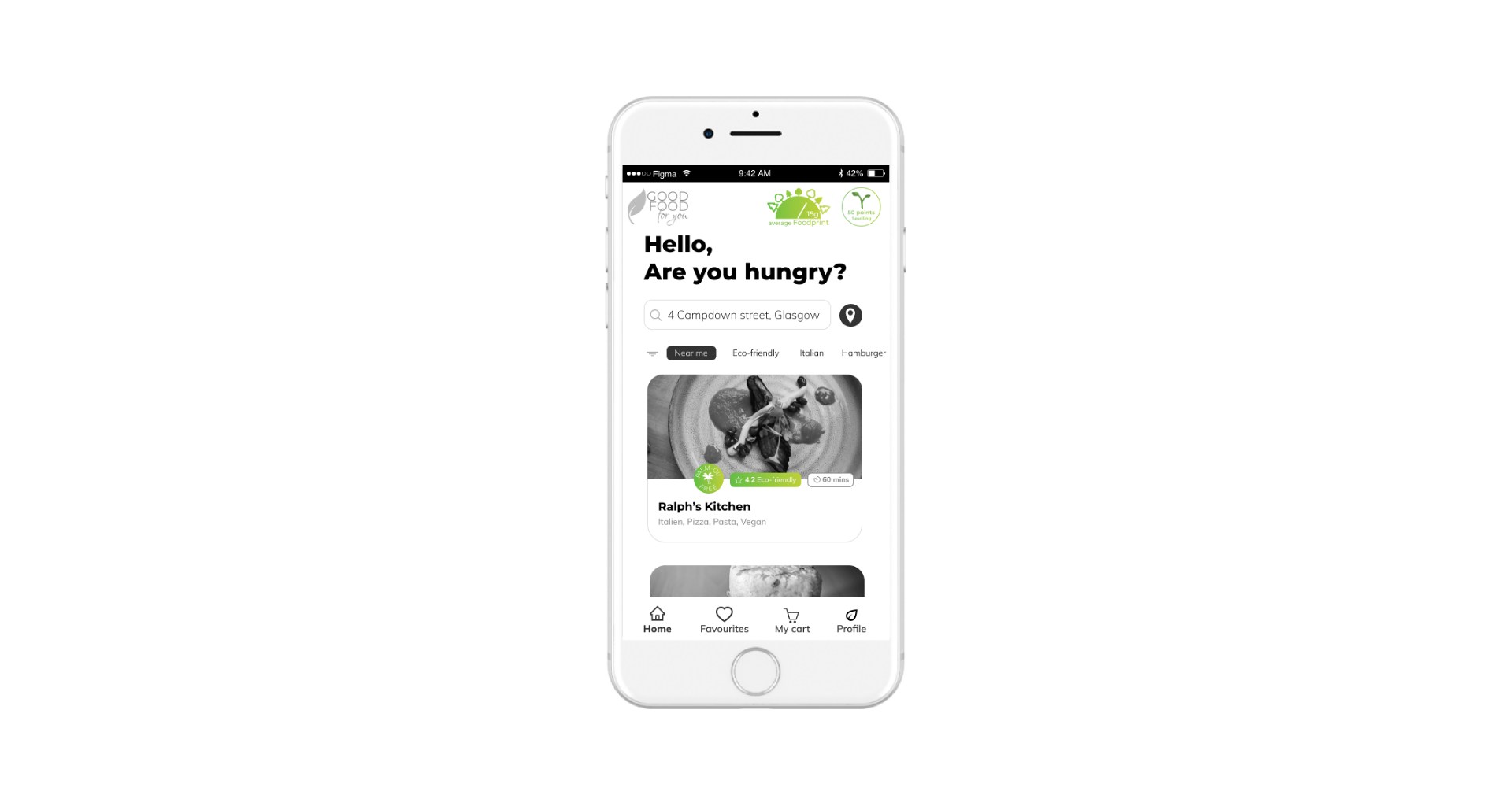
Good Food for You wireframe - Home screen
When it comes to selecting the food itself, users can check the ingredients of each meal and see how eco-friendly they might be. Being conscious of their impact will nudge them to consider their choice more wisely. At the same time the need to display this aspect will encourage restaurants to become more eco-friendly so they can earn higher points and attract more customers.
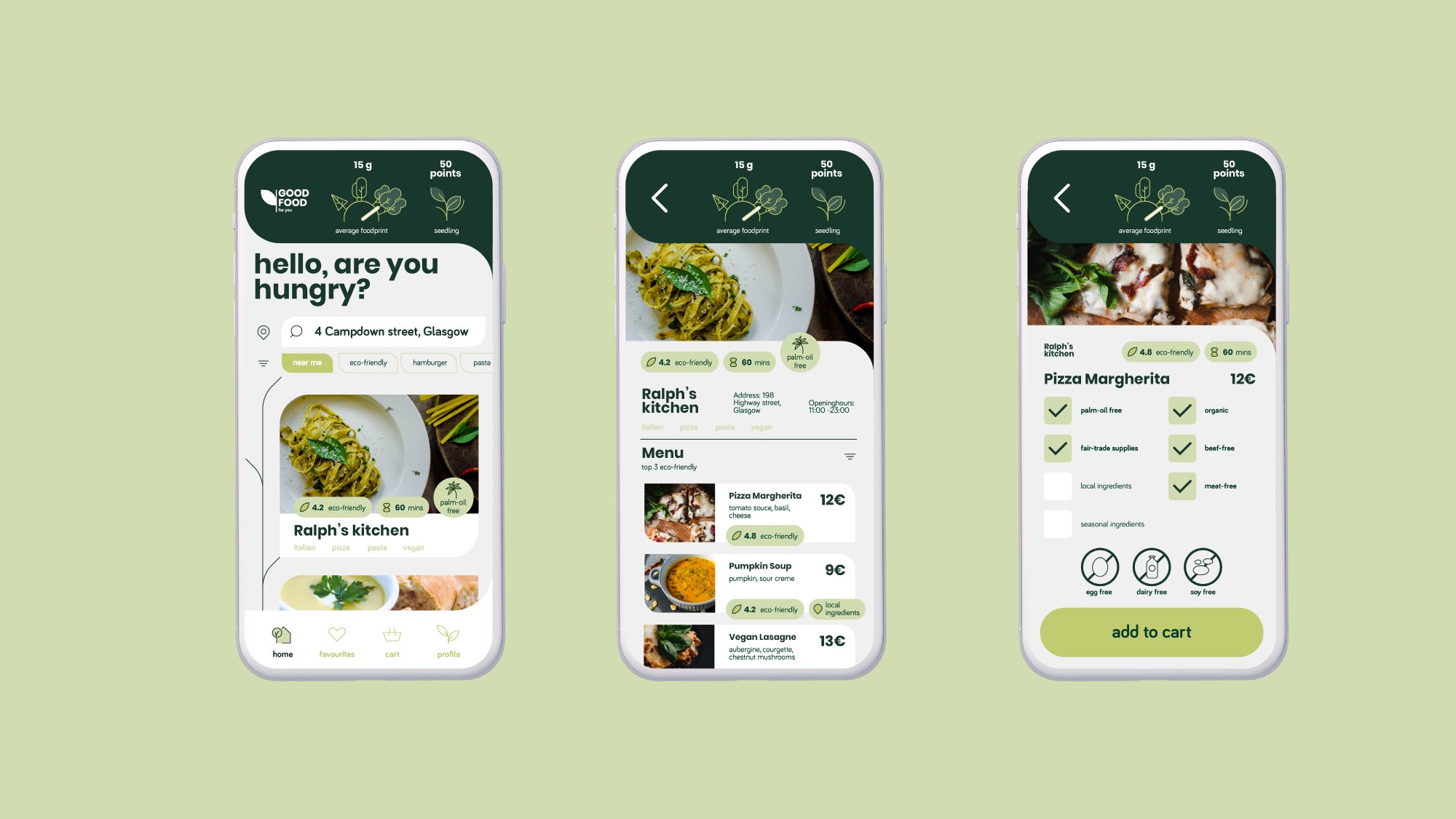
Good Food for You - The app, restaurant menu and ingredients screens
In fact every meal has a rating based on its ingredients’ eco-footprint, which has allowed us to spice up the app with a basic gamification element: users collect points based on how eco-friendly their food is. For each meal, besides the usual list of ingredients and allergens, we decided to display a handy eco-friendly checklist that informs customers whether the given food is organic, meat-free, made of seasonal ingredients, etc.
Our goal was once again to educate users and make them more conscious of their impact on the environment.
Before finalising their order, customers have to answer three quick questions about cutlery, packaging and delivery mode. To nudge them towards the green options, we preselected them by default and also offered points for choosing them. On the one hand, we create motivation through gamification, while on the other hand, we make use of the power of nudging by preselecting certain (more beneficial) options.
There is also the small trick of naming our options cleverly, so they intentionally weigh on one’s conscience. For instance ”Recycled paper package” sounds perfectly fine, while the option below it called “Non-eco-friendly package” sounds like you are trying to kill the environment on purpose…
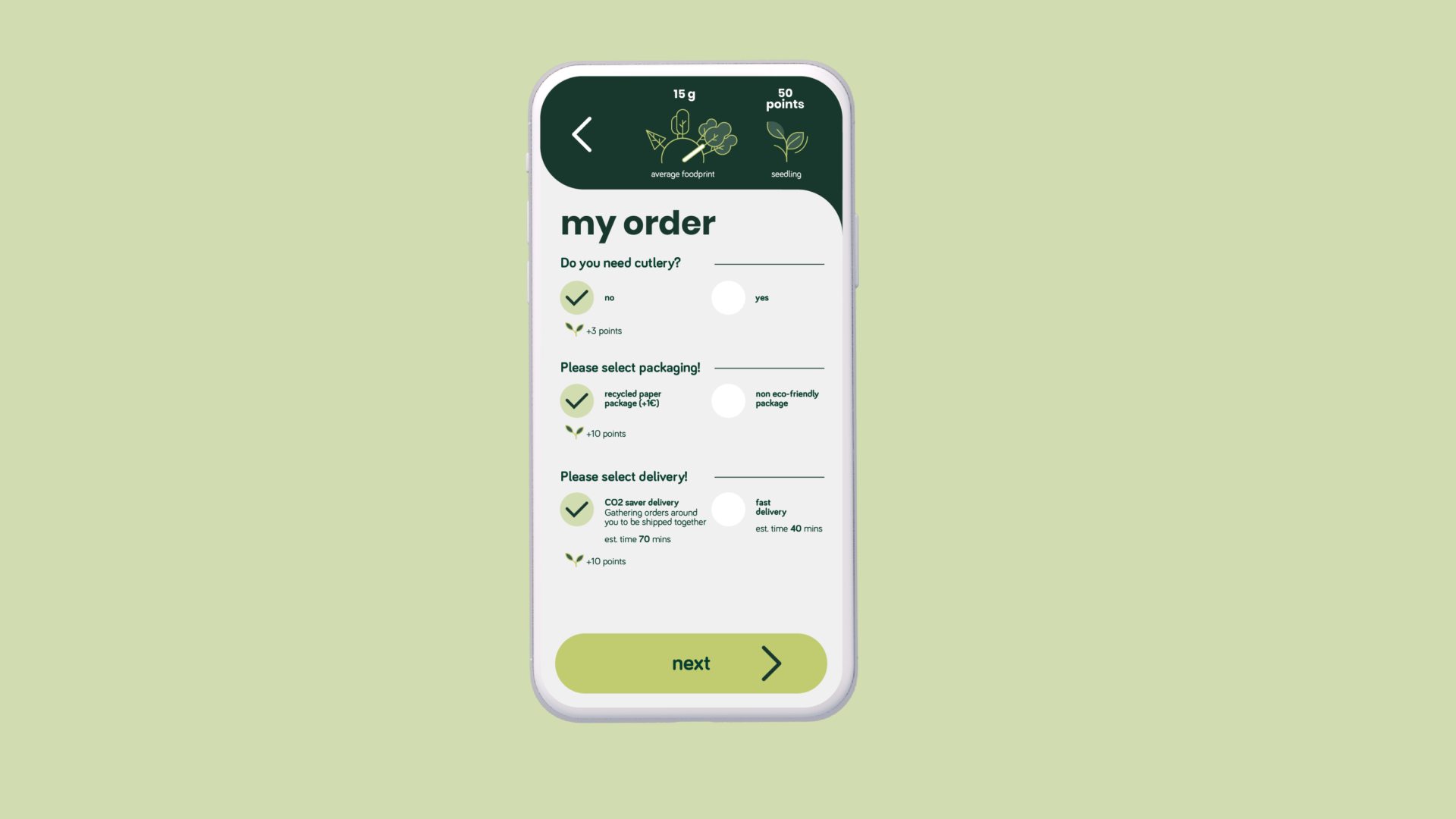
Good Food for You - My Order
Most of the time when we order in, we just receive plastic cutlery without being asked at all – even if we are at home and don’t actually need it. In fact not sending cutlery seems like a beneficial option for both parties: restaurants can reduce cost and customers will be happy for receiving points through the app. Oh, and let’s not forget that the unused cutlery doesn’t end up in a landfill! Such a tiny change… with surprisingly far-reaching results.
The second question discusses packaging. Unfortunately, using eco-friendly recycled containers is more expensive than the usual plastic ones, but considering how many plastic boxes are thrown away daily, we thought it was still worth a quick question. What if someone cares enough to pay the extra price? So, we just let our customers decide for themselves – and try to motivate them to do so the right way with some gamification (see below)!
Finally, users have to make a choice about their delivery method. Usually, when one orders food, they are hungry and just want to get it as fast as possible. But what if they are simply wondering about what to eat for lunch, casually checking options before they actually get to the starving stage? (Yes, some people do that. Most of us… not so much.)
Maybe they are clever enough to order the food ahead of time and don’t mind waiting an additional 15-20 minutes if it’s better for the environment. This option means that the orders are first gathered in each area and then delivered at once, resulting in less CO2 emission.
It is important to clearly indicate the difference between delivery times, as we really don’t want to trick users into a situation they didn’t sign up for (another important rule of nudging). Even so, we are still trying to motivate people to select the CO2-saver option, so we have preselected it and offered bonus points for the greener choice.
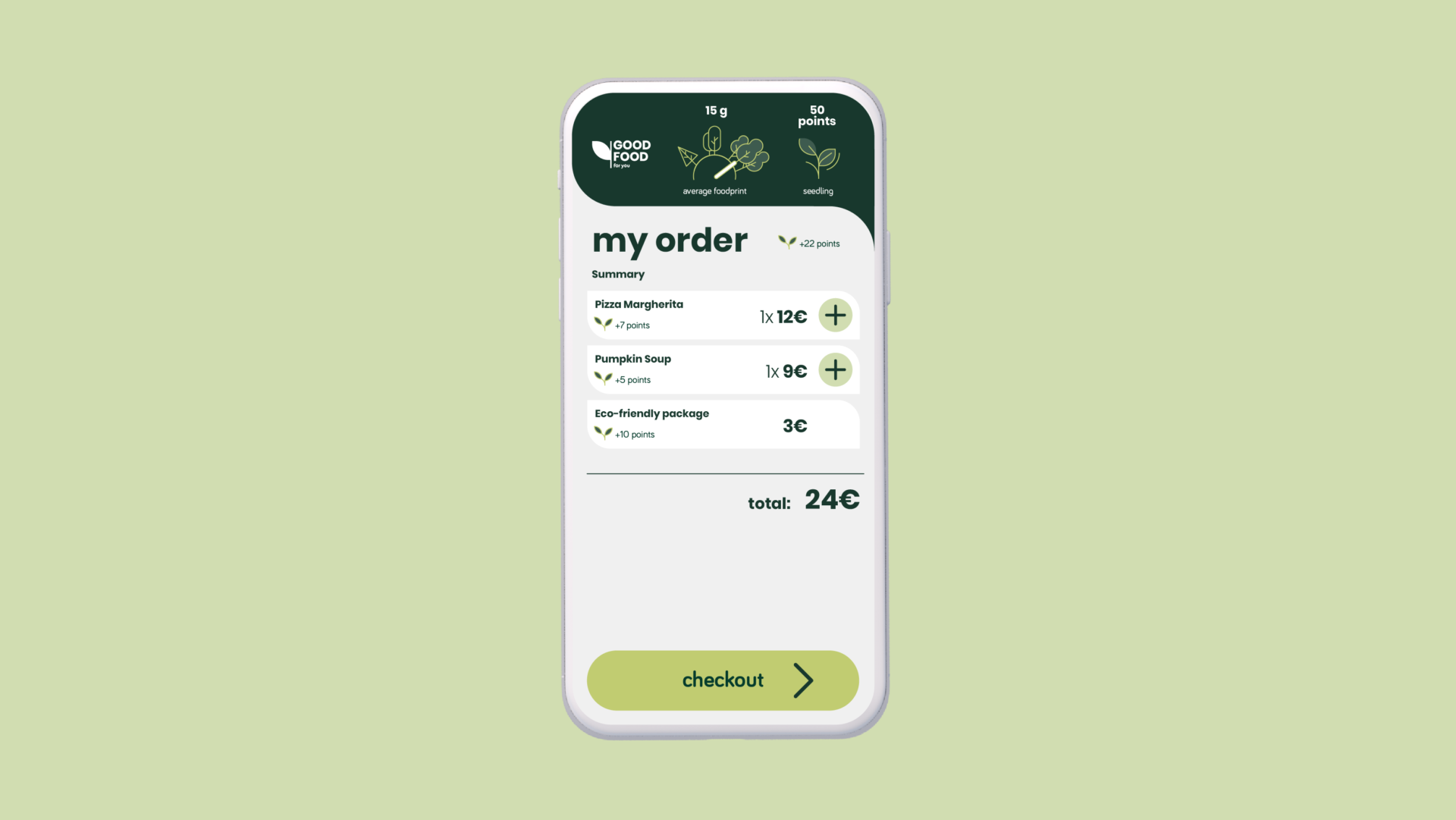
Good Food for You - Checkout
We have already discussed the significance of points and gamification; now let’s examine this angle from a practical perspective.
For our app we have created a gamification system that aims to motivate users to choose options that are more environmentally friendly.
Getting points happens based on the food, delivery option and type of packaging they select. By collecting points, eventually they will receive badges. Immediately after registration each user gets a “seed” badge. To provide a feeling of progress and a way to clearly visualise their status, we have included a progress bar indicating how many points are still needed for their next badge. Users keep earning badges until they acquire the final one called the “fruit”. The entire process of getting from seed to fruit symbolises green choices and an eco-friendly mindset. When a user obtains the final badge, a real tree is planted in their name, and then the cycle restarts with a new seed badge. Naturally, the number of trees planted remains visible at all times to emphasise their accomplishment.
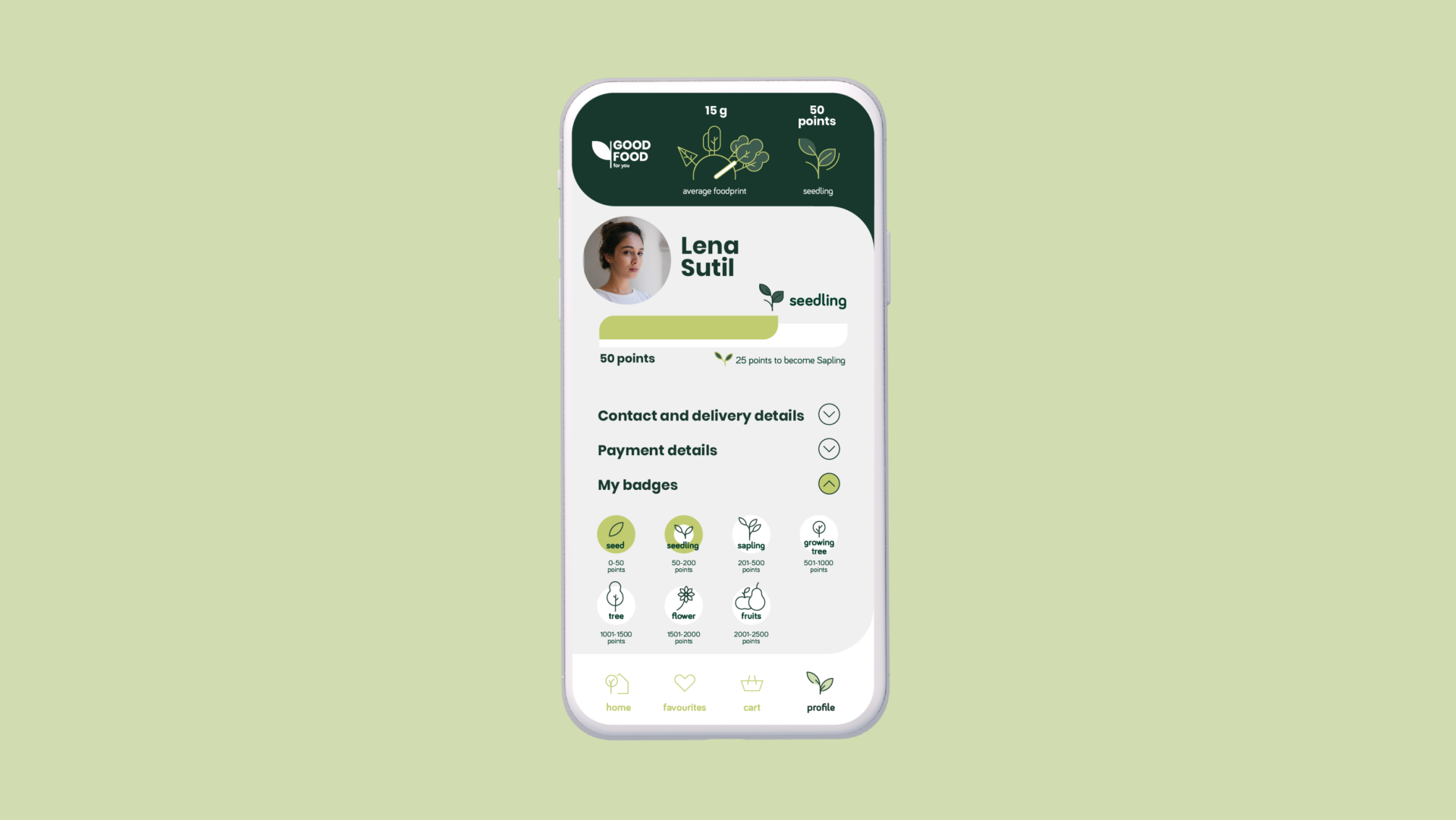
Good Food For You - Profile
In addition to the badge system, we have created a so-called “Foodprint” indicator, which demonstrates the average CO2 footprint of a user’s orders. It is always visible on the top right corner of the screen to remind them of their performance. Should they select a beef hamburger and opt for non-eco-friendly packaging with fast delivery, their Foodprint will deep-dive and the sign will become red, indicating a high CO2 footprint. Predictably, if they order an organic, palm oil-free meal in eco-friendly packaging with CO2-saver delivery, things will look more promising once again.

Our example demonstrates how it is possible to make an average food ordering app a bit more eco-friendly with small Nudges, a few well-designed features and basic gamification elements.
With careful application of these tools, users won’t have a sense of being pushed or controlled, and restaurants will not be negatively affected.
The key is to reward the right decisions and to find the right motivators.
Looking good in green
At Supercharge we feel steadfastly committed towards conserving natural resources and sparing our environment as much as possible. Thankfully, as digital product designers we are in an extremely strong position to act: influencing behaviour is basically part of our job. It’s an opportunity, but also an immense responsibility to use this power for creating a liveable world. Whenever we can, we love to give back and support conservation initiatives and eco-friendly projects – both in and out of the office.
In recent years we have contributed to the birth of several green-minded products and reimagined just as many others, gearing them towards environmentally conscious ways of functioning and arming them with a multitude of eco-friendly features. In fact in 2020 we decided to get our own Supercharger forest – also becoming a certified carbon neutral company in the process. Our tools may vary from nuanced design techniques to a good, old fashioned practice but the mentality and the responsibility remains. Earth is ours to save, and we all have to do our fair share of work to protect it.

